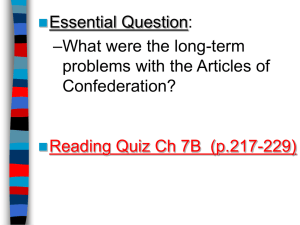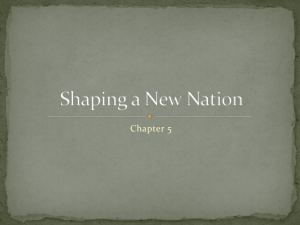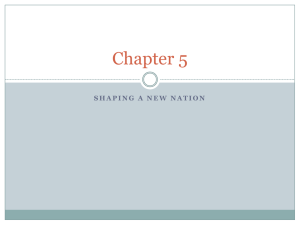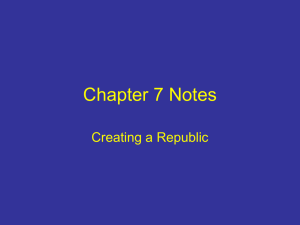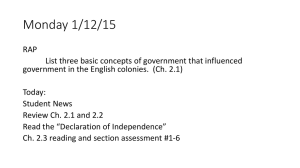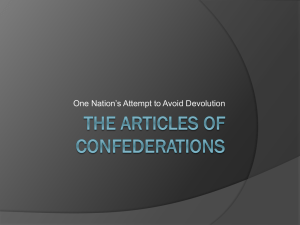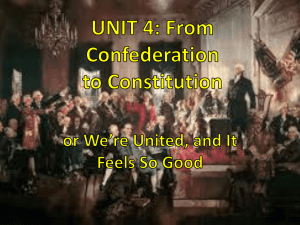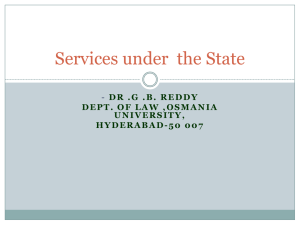Articles of Confederation
advertisement
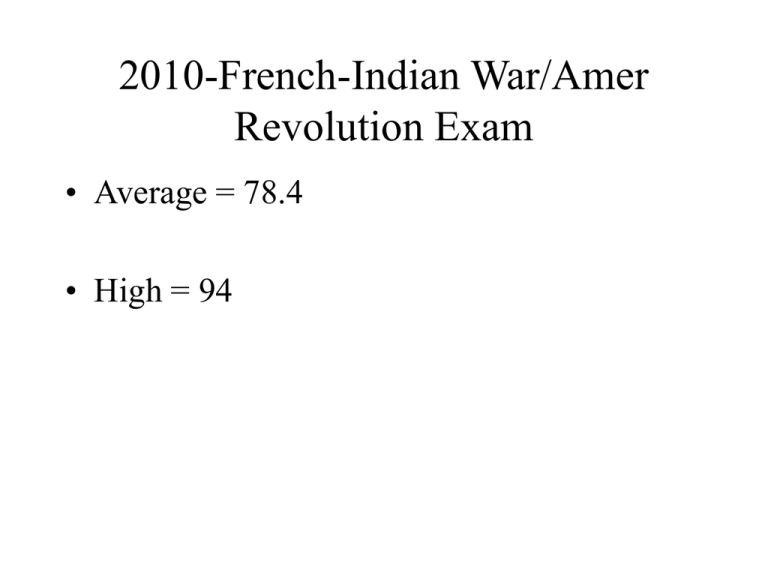
2010-French-Indian War/Amer
Revolution Exam
• Average = 78.4
• High = 94
2009 French Indian WarRevolutionary war Exam
• Class Average: 78
• High: 87
2010
100
90
80
94 92 92
86 84
82 80 80
76 76 74 74 74 74 74
72 72 70
70
60
50
40
30
20
10
0
1
64
2009
Grades
100
90
80
70
60
50
40
30
20
10
0
87 83
83
83 83
83
81
81 79
1
77
74 74
72
70 70
70
MC
20
18
15
15
13
11
11
10
11
8
4 4
5
10
8
5
14
7
6
4
6
3 3 3
4
3
1
2 2 2
0
1
0 0
0
1
3
5
7
9
11
13
15
17
19
21
23
25
27
29
• 1. (p. 101) In the mid 1770s, the relationship between the
British Empire and the American colonies was
characterized by
a. most Americans being happy with their membership in
the empire
b. the British trying to continue the policies of the last
hundred years
C. most Americans becoming disillusioned with the empire
d. the British growing more like the Americans in their
ideas and institutions
e. most Americans taking loyalty oaths to the Crown
• 3. (p. 103-104) During the late 1600s and early
1700s, French settlement in North America was
characterized by the
a. development of manufacturing in Quebec
b. decline of their fur trade with the Indians
c. absence of any significant expansion of their
territory
D. toleration of the Indians' way of life
e. lack of any effort to convert the Indians to their
religion
10. (p. 115) The Mutiny (Quartering)
Act of 1765 was resented by the
colonists because
a. they could now be prosecuted on mutiny charges
for refusing to provide quarters for troops
b. they were required to quarter troops who served
no purpose other than to oppress them
c. some colonies were exempt from the laws
provisions
D. colonial contributions of lodging and supplies
for British troops were made mandatory
e. they had never quartered troops in the past
11. (p. 117) Following the "Boston Massacre"
of 1770, Samuel Adams stirred up public
outrage and then helped to create a committee
of
•
a. vigilance
b. military training
C. correspondence
d. revolution
e. public safety
12. (p. 117-118) Colonial leaders
based their opposition to British
policies on the philosophies of
•
A. all the answers below
b. John Locke, who was a political theorist
c. Scots, who viewed the English as
tyrannical
d. Puritans, who were religious refugees
from England
e. radical ideas from British opponents of
the government
• 19. (p. 128) As the Revolutionary War began, most
Americans believed they were fighting for
a. their independence
b. the acquisition of more territory
c. representation in the British Parliament
D. a redress of grievances against the British
Empire
e. an overthrow of the colonial upper class
• 20. (p. 130) In 1781, the states ratified a
plan for a decentralized national
government of the United States that was
called the
a. United States Constitution
B. Articles of Confederation
c. Declaration of Confederation
d. Confederate States Constitution
e. Declaration of Independence
• 21. (p. 132-133) As commander-in-chief of the Continental
Army during the Revolutionary War, George Washington
A. all of the answers below
b. displayed serious shortcomings as a military commander
c. faced mutinies among his troops and an attempt by
Congress to replace him
d. became the indispensable man because he held the army
and the country together throughout the war
e. earned the respect of nearly all patriots
Fill in
14
12
12
10
8
6
6
4
4
5
4
4
3
2
1
2
3
0
0
0
0
0
0
0
8
9
10 11 12 13 14 15 16 17
0
1
2
3
4
5
6
7
• 7. (p. 114) When accused of treason for
predicting that George III would lose his
head if British policies toward the colonies
were not reversed, _____ supposedly
replied: "If this be treason, make the most of
it."
• Written by 2nd Continental Congress
during War and took effect in March
1781
FAIL!
“All Men Created Equal”
•Mason Dixon Line
set the precedent over
dividing the country
over slavery.
•Ohio River would be
the dividing boundary
between North and
South.
1790
WMA 21 yrs. old, educated and
property owner…….
voting
Several states would drop property
qualifications and education…….
A/C chart
Written by 2nd Continental Congress
during War and took effect in March
1781… Becomes the Confederation
Congress
•Founding Fathers were determined not
to have a king…..
•Our first constitution (law of the land)
and attempt to create a democratic
government based on the ideas of DOI .
The United States in 1787
A/C chart
2. Confederation Government
“Treaty of Cooperation between the states”
govt. of loosely organized states
Each state independent and conducted their own
affairs
Created a weak national govt. which had little
powers to solve US problems
States held more power than US govt.
Would unite in times of crisis.
Government
Structure
Powers of
Congress
State
Responsibilities
•Congress--1 branch
•Confederation
Congress
•No executive branch
or president…
•No judicial
system…..
•One vote per state
regardless of size
•Make war and
peace
•make treaties
•build navy and
army
•settle disputes
among states
•set up monetary
system
•Obey Articles and acts
of Congress
•provide funds and
troops when
“requested” by
Congress
•States regulated own
trade and taxed each
other
•States had their own
currency
3. Major Problem:
Created a weak national govt that
could not tax, regulate trade or enforce its laws because the
states held more power than the National Government.
The Articles of Confederation
4. The Articles of Confederation established
a “firm league of friendship” among the
States.
Confederation
Congress
•Congress was given the
power to declare war.
•Deal with national finance
issues.
•Settle disputes among the
States.
•Request funds (taxes from
states) to pay off debt
Go To
Section:
Obligations
•The States promised to
obey Congress.
•Respect the laws of the
other States.
•Most other powers
were retained by each
State.
1 2 3 4 5
Chapter 2, Section 3
A unicameral (1 house)
Congress
13 out of 13 states to amend
or change Constitution.
Representatives were
frequently absent.
Could not tax, raise armies or
regulate trade.
No executive to sign or
enforce the law.
No judicial branch to settle
disputes between the states.
Could not enforce its laws.
Major Problem
Could not tax,
regulate trade or
enforce its laws
because the states
held more power than
the National
Government.
Why?
Feared a tyrannical
government like King
George
Major Problem
Could not tax,
regulate trade or
enforce its laws
because the states
held more power
than the National
Government.
Why?
Feared a
government like
King George
•13 colonies had a tradition of
governing themselves…..
•Elected their own representative
law making bodies.
•Passed laws to keep peace within
their communities.
• Colonies had a tradition of
representative democracy.
•That’s why they fought the
Revolution.
•The Confederation
Congress created a
National Government
based on representative
democracy.
National Govt.
AOC/Congress
given 20% of
govt.powers
States given 80%
of governmental
powers…States
were over the
National Govt.
Fearing a strong
central govt. like
King George the
AOC created a
weak National
Government that
was not given the
power to tax,
regulate trade or
enforce their laws.
EFFECTS
Could not deal
effectively with US
problems.
Currency
• States had their own currency
Foreign Debt
We owed France, Spain and
other countries who helped us
with the Revolutionary War.
$11,710,000
Individual states owed
citizens who loaned money
to their state.
State Debt
$21,500,000
US Govt. owed
soldier’s for fighting in
the war, debts to
British and Loyalists.
Federal Domestic Debt
$42,414,000
$80 Million
debt
•Disputes with US over land claims led
Spain to build forts.
•Disputes over the Mississippi River
British were to remove their troops from US soil…..The National Government
under the AOC was powerless to force Great Britain to honor the Treaty of Paris,
1783
Jays
Disputed Territorial Claims
Between Spain & the US: 1783-1796
Indian Land Cessions:
1768-1799
State Claims to Western Lands
Northwest
Territory
USA
■Grid system
was created by
Thomas Jefferson…
■Promoted an orderly
expansion westward..
Northwest
Territory
■Confederation Congress
convinced states who claimed
land out west to cede their
land to the US Govt.
■US Govt. was to come up
with a fair and reasonable land
policy…..Unlike the
Proclamation of 1763….
Land
Ordinance
Northwest
Territory
Plot #16 was
set aside for
public
education
Public Land
sold for $1.00
to $2.00 an
acre = pay
debt
An addition to the Land
Ordinance of 1785
Northwest
Territory
Congress sold land in
large blocks, 40, 80, 160,
320 and 640 acres.
$1 to 2$ an acre to help
pay debt.
Encouraged settlers to form townships.
New states formed would be = to original 13
Influx of settlers causes violence with Indians
Guaranteed settlers “unalienable rights”
Ohio
1ST STEP
2nd STEP
3rd STEP
WHEN PEOPLE
FIRST SETTLE IN
THE AREA:
5,000 FREE ADULT
MALES:
60,000 SETTLERS:
Congress appoints a
governor and three
judges to govern the
territory
Landowners elect a
congress to make laws
and raise taxes with
approval of governor. 1
representative is elected
to the US Congress who
can debate but not vote.
Becomes a state, with its
own government and
constitution. New states
admitted with same rights
as the original states. No
more than 5 states can
carved out of this area.
The Northwest Ordinance encouraged ideals of the DOI and republicanism
(representative democracy) religious freedom, protection of liberty and
property, encouraged education, admitted new states and no slavery.
Northwest Ordinance of 1785
Shays
10. Daniel Shay
1785 to 1787, unfair taxes, debt and foreclosure
Farmer’s rebellion to overthrow Mass. Govt.
11. In early 1787 a group of small farmers protested against
the Massachusetts govt.
Why? They were in debt, their homes being repossessed and
unfair taxation.
They were led by Daniel Shays, a former army captain in the
Revolutionary War.
The purpose of the rebellion was to prevent foreclosures by
keeping the courts from sitting until the next election.
Shay’s Rebellion was put down by private army paid for by
wealthy merchants from Boston.
12. The AOC was unable to put down the rebellion with a
national guard or army.
Shays
13. Outcomes
Attacks by Shay followers
Encounters between
Shay’s and hired militias.
Rebellion put down
by a private militia
US Govt. too weak
to put down
rebellion
Americans feared
govt. too weak =
anarchy
Call for a Constitutional Convention to change
AOC and create a stronger national government.
notes3
total chaos, mob rule,
survival of the fittest, no
respect for law and order
or attempting to
overthrow the authority of
govt. = unstable govt. =
no govt.
The Elites Response to
Shay’s Rebellion:
“Respectable”
Americans were
shocked by the
violence. Feared
“mobocracy”.
Let us have
{ a Constitution }
by which our lives,
liberties and properties
will be secured....
Why A New Constitution
The AOC was unable to act decisively
in a time of crisis (could not protect
life, liberty and property).
Provided all the evidence needed to
finally convene and revise the
constitution.
Why was Shay’s Rebellion such a
concern to our founding fathers?
The Elites Response to
Shay’s Rebellion
15. The Annapolis Convention (1786)
H George Washington hosted a conference at his home in Mt.
Vernon, VA (1785)
H Representatives agreed that the problems were serious
enough to hold further discussions at a later meeting at
Annapolis, MD, at which all the states might be represented
H Only 5 states sent delegates
H Alexander Hamilton and James Madison persuaded the
others to call for a Constitutional Convention, to be held in
Philadelphia for the purpose of revising the Articles of
Confederation

